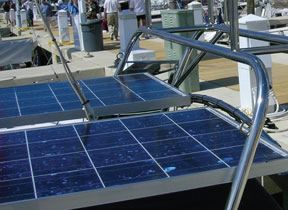
My post last week on storing batteries for winter prompted a couple comments and letters on solar panels, so I thought I’d point out some of our past articles on the topic that can be found online at www.practical-sailor.com. It is a timely project for me, since our upcoming project testing one of the new sonic-pulse antifouling devices will require a solar panel. According to the device’s maker, Smart Antifouling, the unit draws about .08 amps, which means will want to put a small 5-watt solar panel on our Cape Dory 25 test boat, Skimmer, which typically lies on a mooring.
Several readers said they used dedicated trickle chargers to maintain a healthy charge during winter storage, and this will work fine in places that don’t see a lot of snow, ice, or overcast days. The makers typically provide guidance on finding the right size trickle charger for your battery bank. For most sailboats, you won’t need a regulator for a small 2- to 5-watt panel, but you will want one for anything higher than that.
Although these are not as effective as a smart three-stage charging system, we have had good results with some of the units we’ve tested. Keep in mind, the aim with these chargers is to offset the gradual voltage drop that occurs over time, not necessarily to replenish your battery or achieve the highest state of charge. There are several brands of these units, and although we’ve tested a few, we’ve not done a comprehensive test in several years. If there is enough interest, we can put together a broad head-to-head comparison.
Most recently, we’ve had good results with the SolarPulse charger on one of our smaller test powerboats. We will be evaluating one of the more interesting devices, the Batterytender, which boasts an internal charge controller. We do not recommend chargers that plug into cigarette lighters, because the connection is so unreliable. If you cut off a cigarette-lighter connector to hard-wire to the battery, you’ll almost surely need to add a properly rated fuse to the positive lead, since this is usually inside the cigarette lighter plug.
We’ve had mixed results with flexible panels, which tend to fail after two to three years due to water intrusion, even if carefully maintained.
If you are using a larger panel for maintaining your battery in the off-season, you’ll need a reliable regulator, ideally a three-stage charge regulator like the one that PS contributor and bluewater voyager Andy O’Grady used to help maintain the wet-cell 6-volt batteries on his boat. My wife and I would often leave our cruising boat, Tosca, for months with a regulated 80-watt solar panel charging our twin 6-volt T105 Trojan wet-cell batteries, but we also had friends check the voltage and electrolyte level on a monthly basis, in case the regulator failed. Because the panel was overkill for this purpose, we put it in a location that saw only a few hours of sun each day.
With regard to high-output charge controllers: Two brands have come to our attention. Contributor Joe Minick has had good experiences with his Blue Sky Technologies charge controller with multipoint power tracking technology (MPPT). Our recent report on electric boats also mentioned a new controller from Outback that is gaining traction. A couple of readers have also written us about their positive experiences using the Outback charge controller.
If you are pondering mounting options, our 2003 Solar Panel Survey delves into that topic as well as others. A few years ago, we reviewed the expensive SolarStik, a rotating and swiveling mount that maximizes output so long as you are there to tend to it. Past PS contributor Steve Dashew, who is pondering a massive system for Wind Horse, has some nice photos of a high-output solar setup. One thing I liked about our own solar-panel arrangement on Tosca was that the panels could be easily removed in storm conditions, or in ports where theft might be a problem – something to consider as you consider your own installation options.


































Do you have an article on installing solar on the Cape Dory 25?